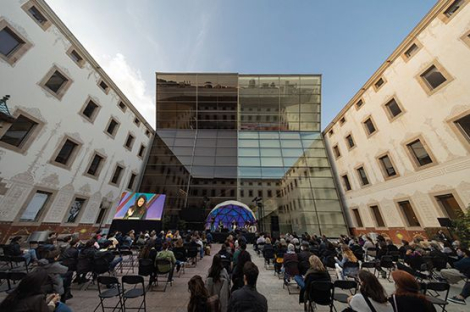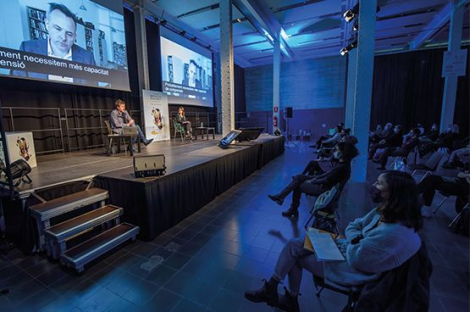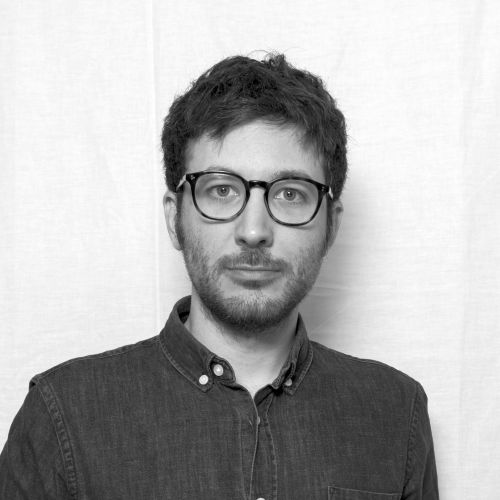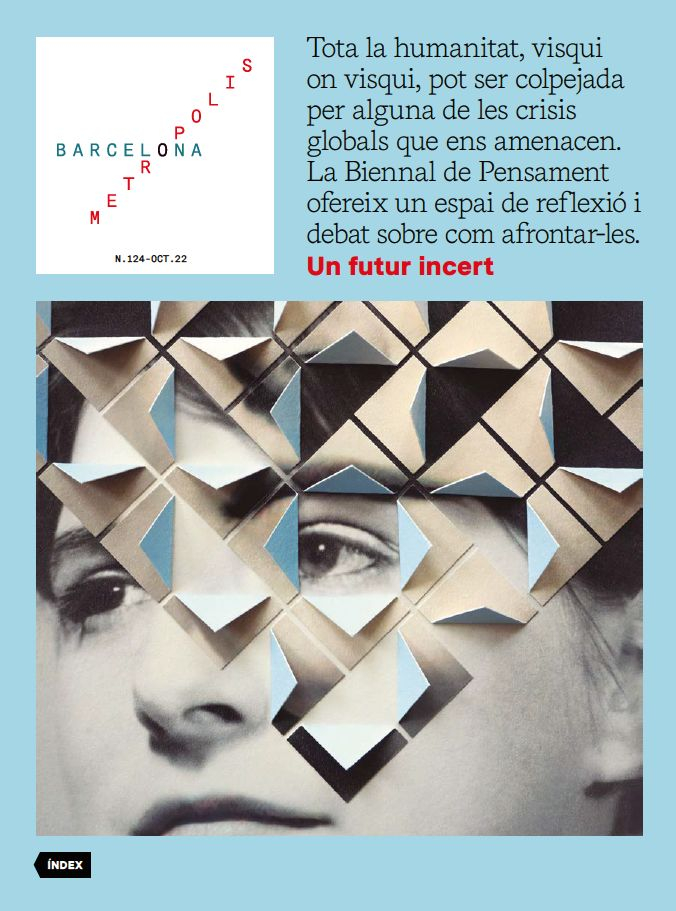Redesigning the city’s cultural fabric
- Culture Folder
- Trends
- Oct 22
- 13 mins
In 2021, Barcelona City Council adopted a Cultural Rights Plan designed to strengthen social cohesion through the recognition of the right to cultural practices, and to promote community action in neighbourhoods. The plan promotes a series of strategic measures that seek to decentralise cultural programming, as well as to generate incentives to create new audiences in the different neighborhoods of Barcelona and its metropolitan area where cultural activity has been rather limited.
Above all, one thing must be clear: culture is a right. This is enshrined in the texts of several international treaties and conventions, starting with Article 27 of the Universal Declaration of Human Rights, which states that “everyone has the right freely to participate in the cultural life of the community, to enjoy the arts and to share in scientific advancement and its benefits”. Culture is a right, although the legal validity of this right is, even now, ambiguous or non-existent in many contexts. There is good reason to believe that, on a global scale, this may be beginning to change.
In mid-2020, while the pandemic was disrupting a strategy for social coexistence that we took for granted, a multi-faceted debate was also raging to reconsider the definition of the parameters of what we could identify as a cultural democracy with guarantees. Those were tough months, marked by uncertainty and concern, for the cultural industry. It was then that the Rome Charter was prepared and signed, a document attached to the city of Rome, but drawn up by different members of the Culture Committee of the organisation United Cities and Local Governments, with a clear international focus, which endeavoured to remind us that “culture is the expression of values, a common, renewable resource in which we meet one another, learn what can unite us and how to engage with differences in a shared space”. These ideas are the cornerstone of the cultural policies demanded by the contemporary city and how to define the profile of its audiences.
The Cultural Rights Plan, approved in 2021, outlines a model for a polycentric and inclusive metropolis, which should mobilise audiences throughout Catalonia.
In June 2021, Barcelona City Council unveiled its Cultural Rights Plan, which aims to strengthen social cohesion through the recognition of the right to cultural practices and the promotion of community action in the neighbourhoods. In line with this aim, it promotes the development of a series of strategic measures linked to the need to encourage the decentralisation of cultural programming, as well as to generate stimuli for the creation of new audiences in certain areas of Barcelona and its metropolitan area where cultural activity was rather limited. “This is an enormous change, because it emphasises the need to recognise culture as a right”, declares Esteve Caramés, Director of Cultural Programmes at Barcelona City Council. “And not only from the point of view of access, but also from the point of view of citizen participation, which goes hand in hand with issues such as interculturality, support for creation, gender parity and the uses of public space and facilities. When we programme, we always do so based on all these factors”.
 Photographs of the Virrei Amat neighbourhood printed on large canvases on the ground in front of the Centre Cívic Can Basté. © Albert Gusi
Photographs of the Virrei Amat neighbourhood printed on large canvases on the ground in front of the Centre Cívic Can Basté. © Albert GusiThis outlines the model for a polycentric and inclusive metropolis, which must be capable of mobilising audiences throughout Catalonia, diversifying the focal points of activity. The impact of this reorganisation of Barcelona’s cultural fabric can be appraised through tangible and well-known examples, ranging from the redistribution of the venues for the Mercè’s events to the role assigned to Fabra i Coats as a leading cultural facility off the usual circuits.
What does it mean to educate audiences?
One of the cornerstones of Barcelona’s cultural policies, possibly its foremost one, is to strengthen the link between culture and education. It’s an interesting exercise, from the point of view of the democratisation of culture, but its balance is delicate. Firstly, because, depending on how it is applied, the concept of education can have paternalistic connotations. “What we are proposing to do is decentralisation, not deconcentration”, claims Caramés. “In other words, it’s not about dictating what should be programmed in the neighbourhoods. It’s about facilitating the natural emergence of culture in them by giving them benchmark venues”.
ICUB’s Educating City and Culture in the Neighbourhoods team has two travelling programmes rolled out through the network of community centres: Temporals, focused on the visual arts, and Barcelona Districte Cultural, dedicated to the performing arts.
This is the area in which the work of the Educating City and Culture in the Neighbourhoods team of the Barcelona Institute of Culture (ICUB) is being rolled out through two travelling programmes, which cover the city’s ten districts through the network of community centres. They are underpinned by a common goal: both programmes have a shared commitment to creating new methods of interaction between the public and the creators that, in one way or another, bring them closer together. These programmes comprise, on the one hand, Temporals, focused on the promotion and dissemination of contemporary visual arts, still in a pilot phase, which currently runs in 13 of the 52 community centres; and, on the other hand, Barcelona Districte Cultural, dedicated to the performing arts, held every two years, which brings together 32 community centres and that has already held eleven editions, during which it has attracted more than 150,000 visitors.
Both Temporals and Barcelona Districte Cultural devote a considerable proportion of their resources to educational work and community relations. They work with a network of cultural connectors, distributed throughout Catalonia, who act as a bridge with groups, associations and schools in each neighbourhood to create synergies and encourage participation in the programmes. The selection of the programme is also open to participation. “There is a project suggestion box that is opened once a year, for a period of time, and everyone can submit their proposals there”, says Modes Roda, coordinator of Temporals. “Once the box is closed, there is a selection committee. In the case of Temporals, it is made up of six of the thirteen community centres that, on a rotating basis, comprises two advisors who change every year, a mediator and two secretaries, who are myself and the person in charge of managing and setting up the exhibitions, with a voice but no vote”.
A network of cultural connectors, distributed throughout Catalonia, acts as a bridge with groups, associations and schools in each neighbourhood to create synergies and encourage participation in the programmes.
The process entails different phases, but decisions are never taken unilaterally by the City Council: the idea is to make it easier for the community centres, in line with the needs of each district, to make the selection, often in turn setting up audience commissions. “We offer, above all, to cover coordination and production”, explains Marta Llatcha, in charge of Barcelona Districte Cultural. “In the long term, this also translates into support for the development of the venues, for example, by providing them with technical equipment, according to the requirements of each show that takes place there”. The philosophy behind these two initiatives is to improve the capacity to engage new audiences and invite them to freely and voluntarily become part of the cultural life in the neighbourhood where they live.
 Round table “Freedom or Life?” in the Pati de les Dones in front of the CCCB’s modern building as part of the Biennial of Thought in October 2020. © Imatges Barcelona / Miquel Taverna
Round table “Freedom or Life?” in the Pati de les Dones in front of the CCCB’s modern building as part of the Biennial of Thought in October 2020. © Imatges Barcelona / Miquel TavernaA good example to grasp the magnitude of this proposal are the two activities that the artist Albert Gusi has organised this year under the Temporals programme. The first, organised around the Centre Cívic Navas community centre, proposed a tour through the history of Navas, designed with the involvement of the neighbourhood’s Associació de Memòria Històrica [Historical Memory Association]. The participants pushed huge inflatable balls, almost two and a half metres in diameter, which Gusi has used in many of his previous projects. “The proposal is to conceive the public space as a recreational, playful, fun space”, Gusi explains. The balls were rolled along Avinguda de la Meridiana and got lost in the surrounding streets. Along the route, the procession made different stops at various important points where some of the older residents told, at first hand, a handful of events and anecdotes from the neighbourhood’s past.
The second activity took place around the Centre Cívic Can Basté community centre. In this case, the proposal consisted of making a photo reportage of the Virrei Amat area, which ended with the collaborative reconstruction of a series of large-format photographs, printed on giant canvases, on the ground of the square where the community centre is located. Gusi has prepared a third activity, planned for the autumn, around the exhibition at the Centre Cívic Joan Oliver-Pere Quart, next to Camp Nou.
The metropolitan audience
All these efforts in the cultural realm are part of a city discourse that has been nurtured in recent years. Thus, for example, Barcelona established a precedent in the way it organises cultural events when, in March 2018, it held the first edition of the Dansa Metropolitana festival, a programme shared with eleven other municipalities in the metropolitan area, which participate across the board and on an equal footing. “It is true that the city of Barcelona inevitably exerts a leadership role due to its size and the volume of people who live there”, explains Esteve Caramés, “but we work on the basis of total parity, in a spirit of cooperation, and aiming to ensure that the rest of the city councils involved can take on this leadership role”.
Besides the necessary incentive that the festival represents for the dance scene and the appeal of its line-up, the importance of Dansa Metropolitana is that it promotes a new model when it comes to demarcating Catalonia: it debunks the nuclear idea of Barcelona and seeks to open up connections between towns such as Sabadell, Cornellà and Granollers. The routes that have been created from this experience of confederated municipalities are serving as a basis for planning other large-scale cultural events. For example, the Manifesta art biennial, a nomadic and internationally renowned visual arts programme that Barcelona is already preparing to host in its next edition, in the summer of 2024. “We are convinced that culture must be metropolitan, and we are increasingly envisaging a metropolitan audience profile, accustomed to taking the metro or the train to go to see what piques their interest”, declares Caramés.
However, this audience Caramés is talking about probably does not yet exist, which is more of an aspiration than a reality. This is very clear if, for example, we compare the number of visits received throughout the year by the two leading contemporary culture centres in Barcelona, Fabra i Coats and the CCCB, with a programme that appeals to similar target audiences. According to official figures, in 2021, Fabra i Coats, located in Sant Andreu, received a total of 11,328 visitors; in contrast, the CCCB, which together with the MACBA heads the itinerary of cultural amenities concentrated in the Raval neighbourhood, received 185,802 visitors.
The route between the CCCB and Fabra i Coats is not sufficiently consolidated to allow audiences to move from one place to the other, partly because there is still a psychological border separating the centre of Barcelona from the rest of the city.
What these figures show is obvious: The route between the CCCB and Fabra i Coats is not sufficiently consolidated to allow audiences to move from one place to the other, partly because there is still a psychological border separating the centre of Barcelona from the rest of the city. The metropolitan spectator is still very much in the minority. It is formulated more as a plan, a future fantasy. And yet this is the key to the debate. Decentralised Barcelona, which not only opens up its scope of action to the peripheral neighbourhoods, but also to neighbouring towns, which it has historically turned its back on, seeks to achieve two goals: on the one hand, it wants to see new audiences emerge where there were none; and on the other, it wants the audiences that already exist to move unreservedly to venues where, until now, the cultural offerings did not tempt them, because of their scattered or limited nature. The challenge this implies has at least two dimensions.
Rethinking the map of the city
The first of these dimensions is cartographic in nature: we need to rethink the way we imagine the map of the city. In this regard, the contributions of a series of initiatives dedicated to rethinking Barcelona’s cultural landscape, leaving behind the centralised model as the only option and forging collaboration networks between different bodies distributed throughout the geographical area, to form alternative culture routes, are crucial.
 Dialogue “The Future Has Been Cancelled” at the Fabra i Coats in the framework of the Biennial of Thought in October 2020. © Imatges Barcelona / Christian Bertrand
Dialogue “The Future Has Been Cancelled” at the Fabra i Coats in the framework of the Biennial of Thought in October 2020. © Imatges Barcelona / Christian BertrandThis is what is done by members of the platform On el teatre batega, developed by the Associació d’Empreses de Teatre de Catalunya [Association of Catalan Theatre Companies], for example, with the aim of consolidating a network of small-format theatres throughout the country. “We try to work together to strengthen the values provided by local theatre and seek strategies to disseminate these values”, explains Marina Marcos, from the co-management of the Maldà, one of the platform’s member venues. “We connect very different areas of Barcelona, with very heterogeneous socio-economic and demographic profiles, because we want to promote the exchange of audiences. That’s why we have created the first multi-theatre season ticket in Barcelona”. Marcos announces, with delight, that through this subscription they have already put more than 1,400 tickets into circulation.
In a similar vein, the GRAF collective works to facilitate regular contact between different spaces all over Catalonia that draw up programmes under the umbrella of the concept of contemporary art. “We seek to mobilise Barcelona audiences, but, above all, we are interested in the synergies between Barcelona’s venues and what is happening in the surrounding area to spark the interest of local audiences”, says Marc Vives, artist and member of GRAF.
The spectator within the creative process
The challenge of reformulating the relationship with audiences has a second essential dimension, related to the way we imagine the spectator’s involvement in the creative process. In recent years, this has been a core topic of discussion on the agenda in many world cities, such as Rome or Mexico City, in which Barcelona seeks and finds references. This is demonstrated in the book A Restless Art, published in 2019, where the artist and researcher François Matarasso analyses the impact of participatory art, and especially community art, thanks to the normalisation of its practice, through the specific cases of fifteen different countries.
According to François Matarasso, when the artistic act is made by professional and non-professional artists together, it becomes an expression of shared humanity, different voices in harmony, listening to one another.
In the final chapter of the book, that of the conclusions, which is expressed almost like a political manifesto, Matarasso writes: “The artistic act is a means of agency in the world, a way to speak and to be heard. When it is made by professional and non-professional artists together, it becomes an expression of shared humanity, different voices in harmony, listening to one another. It becomes a commitment to the idea that we have more in common than separates us, not least in our common human dignity.”
There is no magic formula capable of applying this ideology in a univocal way and making it effective. Perhaps because what these words are telling us is related to the old proverb of trial and error, of working hard at it and, little by little, carving out a path, in order to garner experience and generate new precedents. This is the only thing that, in the long run, can make us savvier.
The newsletter
Subscribe to our newsletter to keep up to date with Barcelona Metròpolis' new developments




